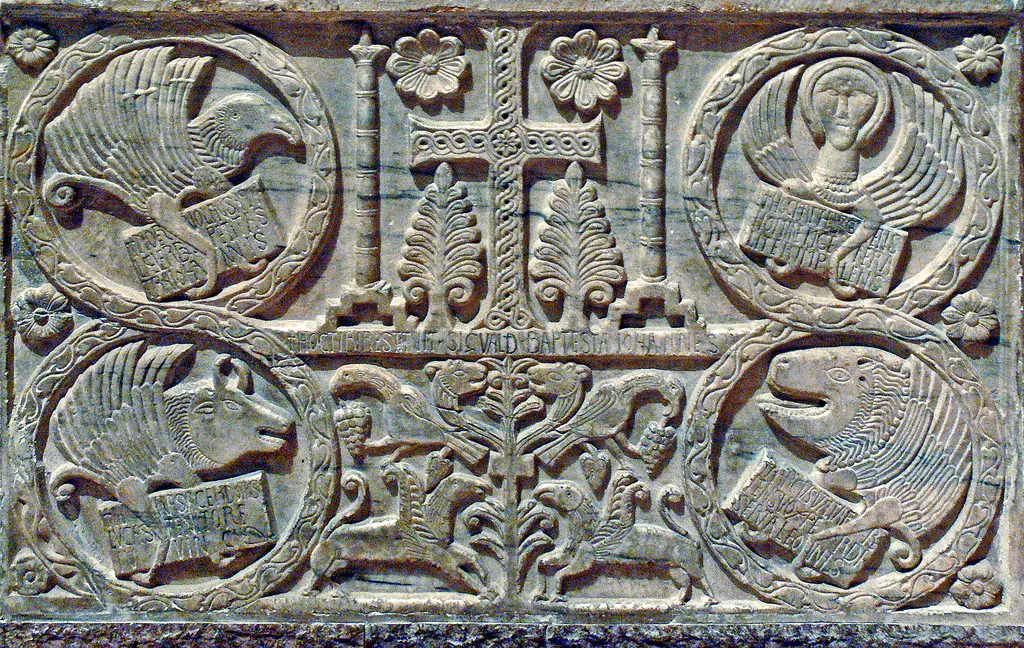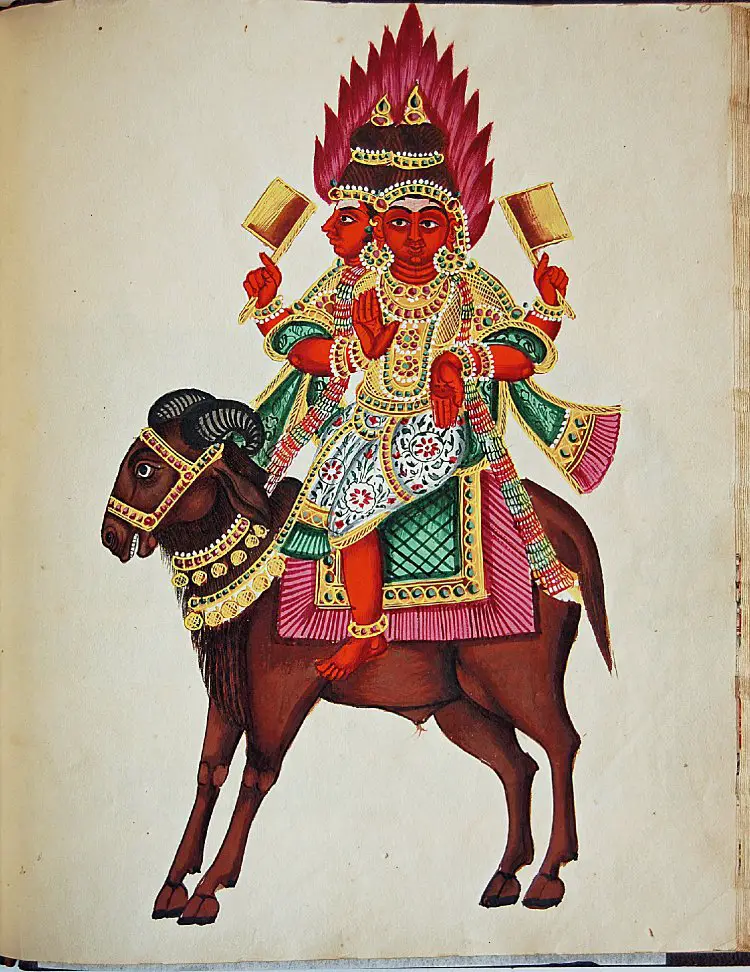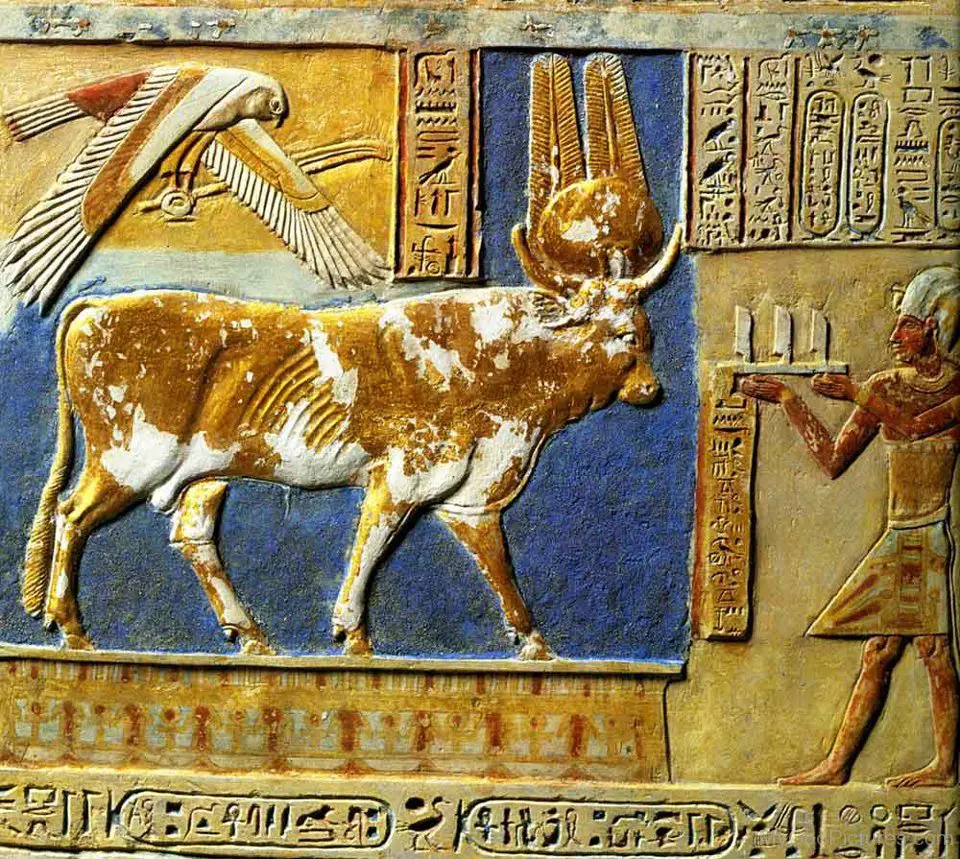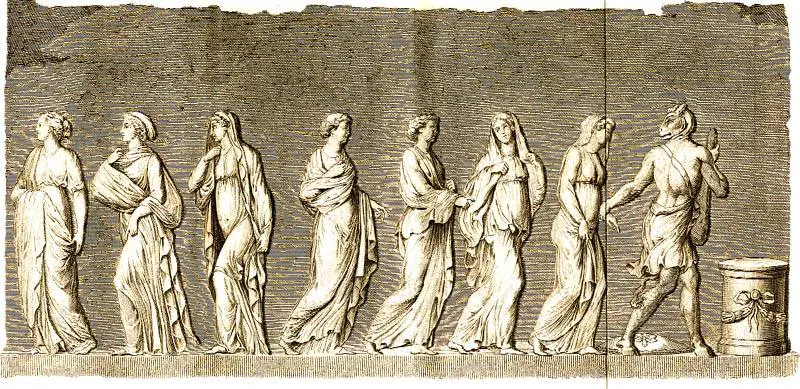di Andrew Casella
It will certainly not go unnoticed by those who are at least a little accustomed to sacred science, a Christian symbol that has always stood out on the facades of churches, adorns manuscripts and is even found on a tarot blade: the tetramorph. This symbol draws its origin from the famous vision of Ezekiel (Ez. 1, 4-28) which St. John later poured into his own Apocalypse. These are four figures that surround the throne of God: the first has the appearance of a lion, the second of a bull, the third of a man and the fourth of an eagle in flight (Ap. 4, 7). Traditionally, these strange figures (which the Apocalypse calls the "Living") are attributed a literary value: in fact, they are the four evangelists, Matthew, Mark, Luke and John. These figures, however, as mentioned, can be found (even more strangely, one might say) also on a tarot blade, and precisely the number XXI, which designates the world.
Indeed, Irenaeus of Lyons (Against heresies, 3, 11 - 8), supports the need for the Gospels to be four, just as there are four corners of the world. It is therefore probable that the above mentioned arcanum of tarot has its iconographic source here. On the other hand, this solution does not allow us to go further; it does not allow us to dissect the essence of the tetramorph. Why precisely those four figures? The answer lies not on earth (or at least, not on that earth as we all commonly understand it), but in heaven. The four corners of the world (whose true notion probably escaped Irenaeus himself) are in reality the two solstitial points and the two equinoctial points, that is, the four points of the year that mark a fundamental change in the apparent course of the sun, and with it is the alternation of day and night. But this will be taken into account later; now, allow us a brief digression-introduction, designed to clarify the purpose of our article.
The traditional doctrine of cyclical time
In the most remote conception of the ancients, what really assumed importance in their eyes was time, marked by celestial events. Since the dawn of time man has scrutinized the sky, seeing in it a large body in motion, very similar to a living being. Lifting his nose up, he could well realize how the stars were not still, but were in continuous, albeit slow, movement. Certainly, such a "soul of the world" must have appeared extraordinary to the dismayed eyes of our fathers, who could not explain why and were completely unable to govern its course. Men watched, and the stars passed by, silent and indifferent; the sun seemed to "die" and then "be reborn" every year; monthly, the face of the moon darkened and then returned to shine [cf. Cosmic cycles and time regeneration: immolation rites of the 'King of the Old Year'].
"It was not a lenient universe, ”Write Santillana and Dechend ne Hamlet's mill (p. 25) "a world of mercy, definitely not. Inexorable like the stars in their course, miserationis parcissimae, the Romans said". However, from a certain moment on, men had to realize that "everything returned": the cosmos appeared to be in constant movement, but not an indefinite movement, without safe landing places, but a movement that "had a sense", circular. The authors we have just mentioned continue: "Yet, in a certain way, it was a world not forgetful of man, a world where everything found, by right and not only statistically, its recognized place ... Because the order of Number and Time was a total order that he kept everything and to which everyone - gods, men and animals, trees and crystals, the same absurd wandering stars - belonged, all subject to law and measure".
Here then, thanks to the revolution of the sun, the dead vegetation flourished and gave the wheat and the vine for bread and wine, according to the monthly cycle of the moon the woman had her own menstrual cycle, which testified to her fertility. Our fathers rotated on time, rather than on space, as we do, which cyclical time has completely obliterated. But there can be no time, for the ancients, without sky: sky and time, so to speak, simul stabunt et simul cadent. Says Plato (Timaeus, 38 c): "Time, therefore, originated together with the sky". Otherwise, one would not understand why the myth attributes Kronos as a son to Uranus. The sky is the venerable object of the ancients: it is the guardian of time, that is, of order, since it reflects the universal soul, whose life is number and proportion. Plato explains all this well in his Timaeus (para. 28 ff.), He who was imbued with Orphic and Pythagorean knowledge, direct filiations of primordial astronomical science, for which everything, after all, "is number". And the number is sum precision. Heraclitus (Fr. 25) he said that Hèlios will not go beyond his measure, otherwise the Erinyes, ministers of Dike will surprise him. There is therefore a "justice" that governs the cosmos. It is manifest, it is there for all to see.
For this reason Plato declares that the sense of sight is the prince of the senses (Timaeus 47 b): "Sight has become for us the cause of the greatest usefulness, because none of the current discourses about the universe could ever have been uttered, if we had not seen the stars, the sun and the sky. Now, the vision of day and night, months, periods of years, equinoxes and solstices has given us the number, the notion of time and the investigation of the nature of the universe.". In short, no primordial metaphysics, no innatism: first of all there is the empirical observation of the motion of the stars. He who wants to be truly wise, says Plato in another place (Epinomis, 989 c - 990 b), he must become an astronomer. Indeed, he still says (Timaeus 47 b), that philosophy, an invaluable asset of men, derives precisely from the study of the stars. In practice, there can be no study of metaphysical principles (although they are the first), without the preliminary study of the sky, guardian of time, which (Timaeus 37 d - 38 b) of eternity is a moving image that proceeds circularly according to the number. In this circle everything passes and returns, as Anaximander had already said, with mysterious accents: "Where all things are born, they must also end up as needed. They must in fact make amends and be judged for their mutual hatred, according to the order of time ". Chronos e ananke, Time and Necessity, were also the two supreme deities of Orphism. But we must not lose sight of the essential fact: in principle, for the ancients the "things" that pass and return are exquisitely the stars [cf. Cyclical time and linear time: Kronos / Shiva, the "Time that devours everything"]

The esoteric meaning of the tetramorph
If we mind the sky, which is time, then the four figures of the tetramorph cast the mask, so to speak, and reveal themselves for what they really are, namely the four constellations in whose houses the sun was at the equinoxes and to the solstices in a very specific period of history. This is explained as follows. The world is actually the quadrangular "earth", made up of the ideal plane that passes through the aforementioned four points, but these, in this specific case, refer to the equinoctial and solstitial condition as it was between 4200 BC. C. approximately and the year 2200 BC approximately. The tetramorph presents the figures of the Bull, the Aquarius Man, the Eagle, which replaces the Scorpio as paranatelon (i paranatellonta are constellations that arise simultaneously with others) and Leo. At that time the spring equinox was under the sign of Taurus, the winter solstice under the sign of Aquarius, the autumn equinox under the sign of Scorpio (or the paranatelon of Aquila) and the summer solstice under the sign of Leo.
Due to the precession of the equinoxes, these constellations were later replaced: thus, in the place of Taurus the Aries, in the place of Aquarius the Capricorn, of the Scorpio the Libra and of the Leo the Cancer. These are, however, the astrological signs that continue to persist on our calendars, although the related constellations, over the last 2000 years, have themselves been replaced. Although, in fact, on the Julian calendar the astrological signs have remained unchanged (which are those of the time in which it was composed, around 50 BC), however, the constellations in the sky are not. Currently, the sun rises at the spring equinox not in Aries, but in an unspecified point between Pisces and Aquarius; a sort of astrological "no man's land". Astrological signs and constellations no longer coincide. As a result of the precession, the latter, which arise eliacally at the equinoxes and solstices, have changed. Our time is crystallized in a strange past that does not pass. One progresses indefinitely, but, one might say, in a time beyond time.
THEApocalypse di Giovanni, then, shows us the celebration, in mystery language, of the constellation of Aries, which rose eliacamennte on the vernal equinox about 2000 years ago. This is what the triumph of the Lamb is mentioned in that text. But, at the same time, the mystagogue must also celebrate the opening of the final time, which comes with the Age of Pisces, the eternal Golden Age. So (Ap. 21, 4): "There will be no more death, no mourning, no screams, no troubles, because the former things are gone". The ancestral time cycles yield to eschatology [cf. The doctrine of the Eternal Return of the same: from Berosus to Eliade].

A 26.000-year-long motion
The axis of the world, which is the imaginary line (similar to a pole or a tree trunk) that crosses the Earth from the north pole to the south pole, is not perfectly perpendicular to the celestial equator (which is the ideal extension of the line of the Earth's equator in space), but tilted about 23 °. This fact, combined with the gravitational forces against which the Earth has to fight in relation to the Moon and the Sun, make this axis rather "tilting". On the two-dimensional plane it corresponds to an oscillation, while in the three-dimensional dimension it corresponds to the movement of a spinning top that is about to stop. To complete a complete oscillation (or the corresponding spin of the top) it takes about 26.000 years (to be precise 25.776).
This movement is called the "precession of the equinoxes" and is a very slow movement, almost imperceptible, when compared to other earthly movements such as rotation or revolution. Nonetheless, it is a movement that can be observed, if one has the necessary patience. During the year (over the course of about thirty days) the sun seems to move along each of the twelve constellations (or houses) of the zodiac, so that, by placing our face to the east on any day of the year, we could see, time after time, the sun rise in the portion of the sky occupied by one of the twelve zodiacal constellations. The "crucial" days of the year are evidently the two equinoxes and the two solstices, because the first two are the points where the celestial equator crosses the ecliptic, while the other two are the points where the axis of the world crosses the ecliptic. The greatest importance is traditionally attributed to the equinoxes, and especially to the vernal equinox, which in ancient times opened the year.
The cosmic geometry thus delineated makes a sort of "earth" appear in the cosmos, which is the ideal plane of the ecliptic passing through the equinoxes and solstices. Often, this land is called quadrangular, because if the vertices of the four points are joined together, a kind of lozenge results: in this regard the ancient Chinese coins with a square hole in the center are revealing; that square is none other than the plane passing through the four cardinal points of the sky. In fact, it is convenient to imagine a square inscribed in a circle, where the circle represents the ecliptic at 360 ° (the "sky"), and the square the "earth" of the constellations included between the four cardinal points. This earth, observed from the plane of the celestial equator, is partially "submerged": a part of it, with approximately six constellations, north of the equator, culminating in the summer solstice, constitutes the "emerged" earth, while the the other half, with about six others, south of the equator, culminating with the winter solstice, constitutes the land "submerged" by the sea. This is where the hemisphere of the "waters" is, and several traditional clues suggest that these "waters" were in turn divided into two bands, the first, that of the "salty sea", from the equator to the tropic of Capricorn, the second, that of the “sea of milk”, from the southern tropic to the south pole.
The critical fact is that the equinoctial points (and consequently also the solstitial ones) do not remain fixed where they have been observed for a certain period, ie in the same position with respect to the sphere of the fixed stars. On the contrary, they move along the ecliptic in the opposite direction to that followed by the sun in its annual course, that is to say against the progressive "right" order of the zodiac signs: Taurus - Aries - Pisces - etc., instead of Pisces. –Aries – Taurus-etc. This phenomenon is due to the fact that the sense of slow precessional rotation of the world axis is clockwise, while the sense of revolution around the sun is counterclockwise, and therefore the "vernal point" (or equinoctial point) is reached every year with some fraction of advance, with the result that it moves very gradually backwards through all twelve houses of the zodiac, pausing in each of them for about 2200 years. (which correspond, graphically, to a segment of about 30 ° on a planisphere divided into twelve sections), and completing a complete circuit in about 26.000 years.
The authors write Hamlet's mill (pp. 85 - 86): "The position of the sun between the constellations of the vernal equinox was the hand that marked the hours of the precessional cycle, very long hours, since the equinoctial sun occupies each zodiacal constellation for about 2200 years. The constellation that rose in the east immediately before the sun (that is, the one that rose eliacally) marked the "place" where the sun rested. It was called the "bearer" of the sun and the main "pillar" of the sky, since the spring equinox was recognized as the faith line of the "system", the one that determines the first degree of the circle traveled by the sun during the year, as well as the first day of the year. At Tempo Zero"That the Authors indicate in 5000 BC, since it corresponds to the mythical Golden Age, on the basis of a particular (almost" golden ") crossing of all the main celestial lines"the Sun was in Gemini; then it passed very slowly from Gemini to Taurus, then to Aries and finally to Pisces, where it is still found today and where it will continue to remain for a few more centuries. Our age is marked by the advent of Christ the Fish. Virgil, shortly before the Year of the Lord, greeted her with the words "a great series of centuries is born again", which gave him the strange title of prophet of Christianity. The previous age, that of Aries, had been announced by Moses who came down from Sinai "with the two horns", that is, crowned with the horns of Aries, while his disobedient flock insisted on dancing around the "golden calf ”, Better understood as a“ golden bull ”, the Taurus".

Conclusion
It is easy to see how in the course of history, the civilizations close to us have adopted a particular symbol from time to time, attributing solar prerogatives to it. If a constellation rises eliacally at the equinox, giving the beginning of the year, it will evidently identify itself with the Sun. And so, for example, we have in Egypt the sacred ox Api, which is attested since the most remote antiquity, around 3000 BC C. (so according to Eliano). Widespread are the depictions of Bees with the solar disk placed between the horns. Thus the idolatrous Jews, who came out of Egypt, still worshiped the golden calf; the bull was equally important in Crete (think of the famous Minotaur, an icon still used in later times for some strange depictions of Dionysus), just as in Persia there was the sacred bull Gavaevordata, the progenitor of all living beings, created by Ahura Mazda.
Of course, adapting the cults to celestial events is not easy, and it may happen that the ancient solar deities coexist alongside the new ones: thus, among the androcephalic bulls, the Persian kings take on the title of "Lamb", under whose appearance they are seen by Daniele (Dn., 8, 20), and Kay Khusraw may declare (Shah Namah)The whole world is my realm, everything is mine from Pisces down to the head of the Bull"- meaning that he is the ruler of the Age of Aries, which on the ideal zodiacal planisphere occupies the 30 ° segment between Taurus and Pisces. He is therefore a ruler who reigns over time, not space. Similarly, in Egypt, the ox Api is later associated with Ammon, with ram horns, and it is significant that he even the Koran (Sura XVIII) keep the epithet of “Bicorne” for Alexander the Great, recognized as the son of Jupiter Ammon by the oracle of Siwa. In India, in parallel, we have Agni (whose sacred name opens the Vedas under the banner of the famous Agni mile purhoitam ...) with a ram as a cockpit; his Norse counterpart is Thor, whose chariot is pulled by a pair of rams.
The late ancient cult of Mithras is also an example of this "survival" of "antecedent" worlds: the act of killing the bull symbolizes the opening of the new year. Taurus (source eliacally at the spring equinox in the homonymous era) is opposed by Scorpio (often depicted in the act of attacking the testicles of the Mithraic bull), ie the constellation that once rose eliacally at the autumn equinox. In fact, it is clear that if the sun rises eliacally on the "emerged earth", so will its "counterpart", in the exact opposite point, "underground". All these images come down to us cloaked in the halo of myth, and it is not easy to disentangle them, especially since the language of myth is exactly the opposite of the discursive one we moderns are used to. Before Logos There is the myth, and the latter, for obvious reasons, does not know how to express himself with technical terminology.
Similar to deaf, they listen and do not intend ...
(Heraclitus, 50 francs)

Bibliography:
- Charles – Francois Dupuis: The origin of all cults, compendium, (Fratelli Martini, Milan, 1862).
- Giorgio de Santillana - Herta von Dechend: Hamlet's mill (Adelphi, Milan, 2003).
- Graham Hancock: Footprints of the gods (Corbaccio, Milan, 1996).
- Angelo Tonelli, Heraclitus: of the Origin (Feltrinelli, Milan, 2012).
- Plato, Timaeus (BUR, Milan, 2014).

I think that the tetramorph could also be linked to a metaphor of the Four Elements of tradition:
- Leo (always associated with heat-fire) linked to Fire;
- The Eagle linked to the Air;
- the Angel (the winged creature with the head of a Man) tied to Water;
- The Taurus linked to the Earth;